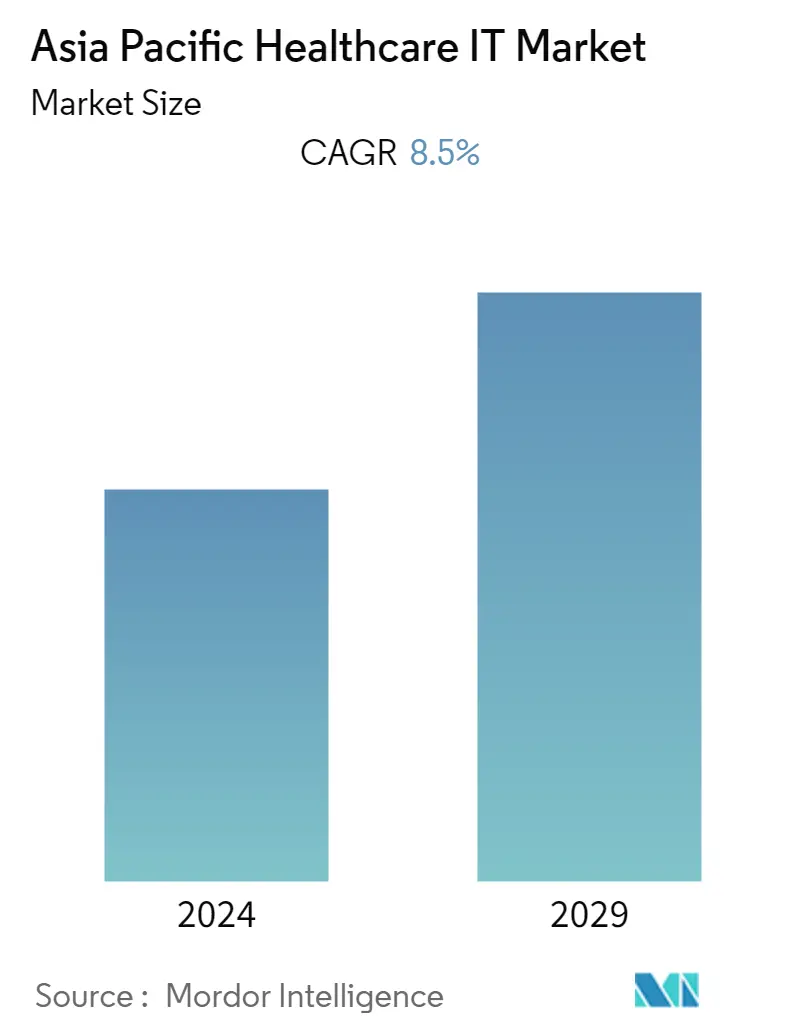Market Size of Asia Pacific Healthcare IT Industry

| Study Period | 2019 - 2029 |
| Base Year For Estimation | 2023 |
| Forecast Data Period | 2024 - 2029 |
| Historical Data Period | 2019 - 2022 |
| CAGR | 8.50 % |
| Market Concentration | High |
Major Players
*Disclaimer: Major Players sorted in no particular order |
Need a report that reflects how COVID-19 has impacted this market and its growth?
APAC Healthcare IT Market Analysis
The Asia Pacific healthcare IT market is expected to register a CAGR of 8.5% during the forecast period. The growing demand for remote patient monitoring solutions, owing to the aging population and long-term chronic disease conditions, is the primary factor impacting the growth of the market.
- There has been an increased usage of technology in the healthcare sector to improve the workflow of nursing staff, and hospitals are equipping nurse ID badges with an RFID tag that works with the hospital's Wi-Fi network. These tags track the movement of the nurses throughout their shifts. The data is captured and analyzed, providing insights to the hospital to improve the processes. Also, there is constant pressure on hospital administrators to lower costs while continuing to improve the level of patient care. Hospitals are turning to modern technologies and analytics in this environment to operate more efficiently, support patient care, and improve their experience. This is further driving the growth of the healthcare IT market in the Asia Pacific.
- Moreover, governments are taking initiatives to set up new and advanced healthcare facilities in developing countries to cater to the requirements of the growing population. The rise in the number of healthcare facilities will increase the demand for advanced medical equipment, which is expected to drive the Asia Pacific healthcare IT market. Additionally, technological advancements in healthcare equipment, growing incidences of chronic diseases, and the rising demand for portable and home-based devices are also driving the growth of the healthcare IT market in the region.
- The market is also witnessing various key mergers, acquisitions, and investments by key players as part of its strategy to improve business and their presence to reach customers and meet their requirements for various applications. For instance, in June last year, Fujitsu and Salesforce Japan Co., Ltd. declared the start of a collaboration to create new digital solutions for the healthcare sector in the entire Japanese market. The two companies would cooperate with insurance companies and medical institutions to assist in developing insurance products that optimize the total risk assessment of diseases by individuals based on data such as the possibility of diseases predicted by AI from medical and health data.
- However, the high cost of medical supply devices and strict government regulations and guidelines restrain the market's growth.
- COVID-19's economic impact in the Asia-Pacific caused a distinct bifurcation between public and private health systems. Private health systems are finding ways to replace revenues lost to local and international travel restrictions. Moreover, public health systems increasingly focus on value-driven outcomes as they respond to the COVID-19 pandemic's extraordinary demands. Furthermore, governments are diverting funds to healthcare and economic stimuli. With widespread lockdowns and patients being increasingly hesitant to go to clinics or any clinician for fear of COVID-19 infection, many patients have turned to telehealth and telemedicine as an alternative to in-person healthcare visits.
